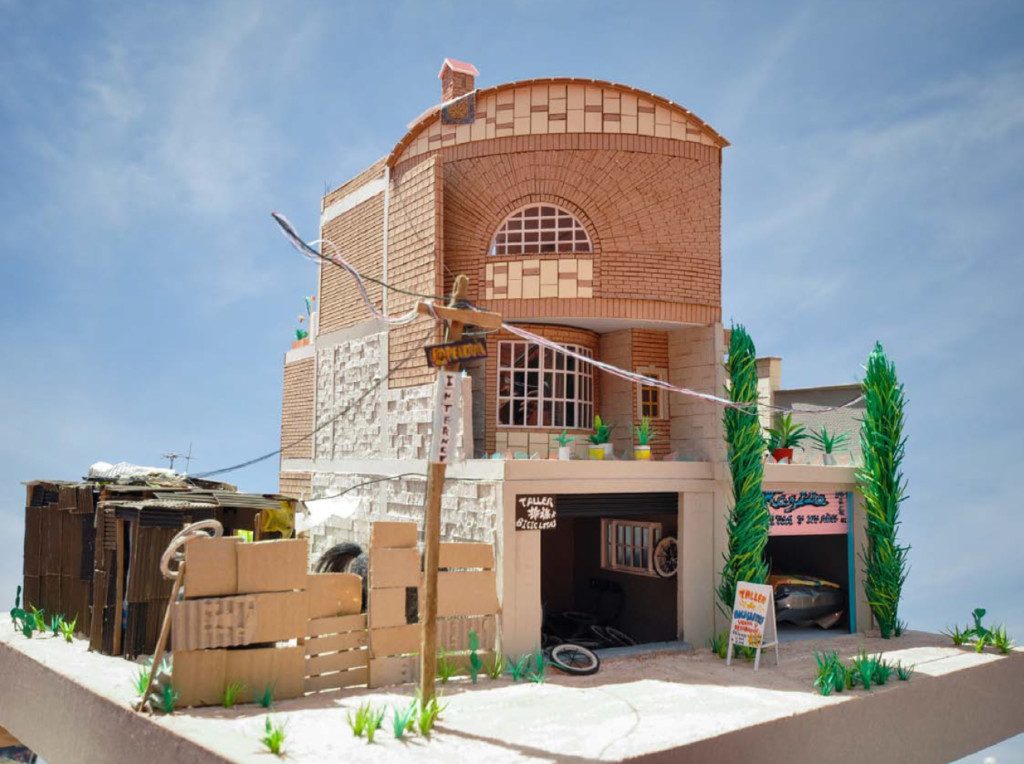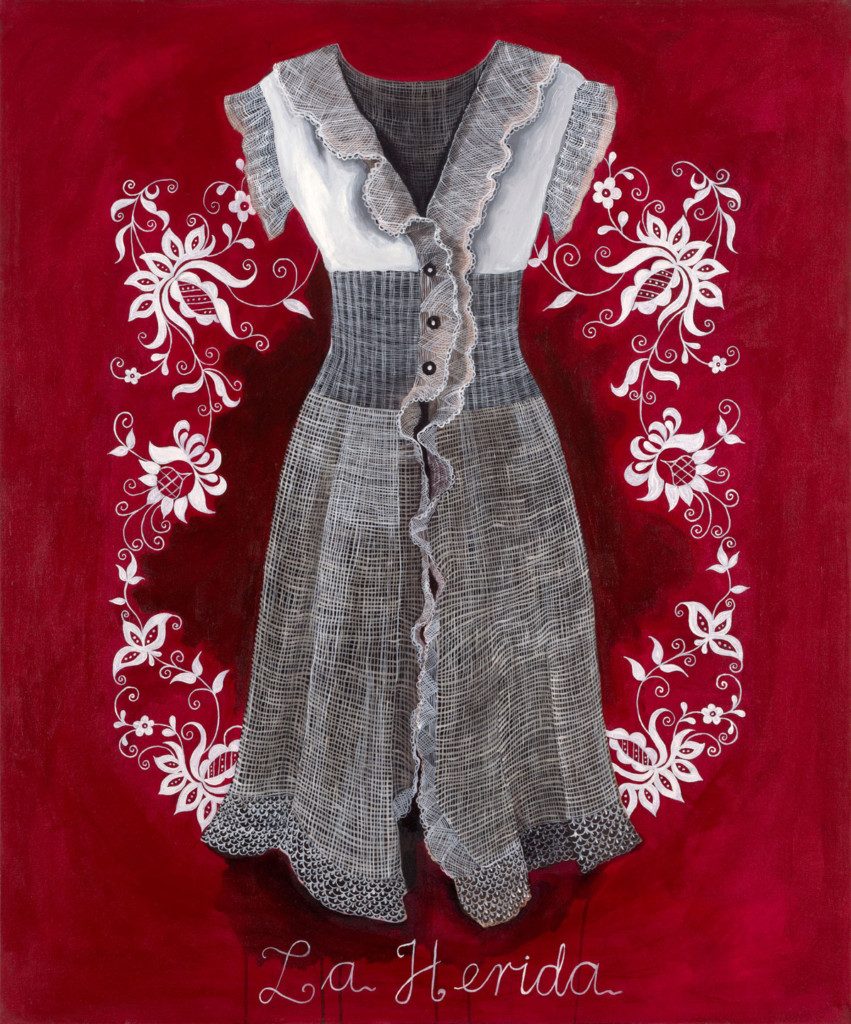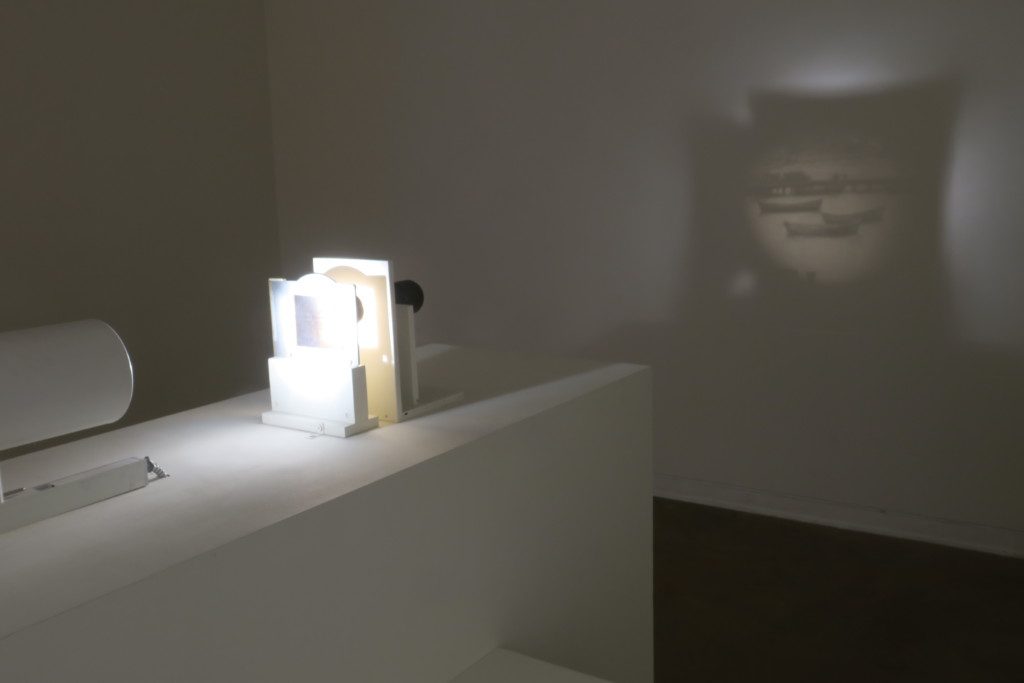Transpacific Borderlands: The Art of Japanese Diaspora in Lima, Los Angeles, Mexico City, and São Paulo
Curated by: Clement Hanami, Exhibition Curator, with Miho Hagino, Kris Kuramitsu, Michiko Okano, Jaime Higa, and Claudia Sobral
Exhibition schedule: Japanese American National Museum (JANM), Los Angeles, September 17, 2017–February 25, 2018
Exhibition catalogue: Emily Anderson, ed., with essays by Lawrence-Minh Bùi Davis, Miho Hagino, Lane Ryo Hirabayashi, Jaime Higa, Kris Kuramitsu, Michiko Okano, and Maria José Plascencia and George J. Sánchez, Transpacific Borderlands: The Art of Japanese Diaspora in Lima, Los Angeles, Mexico City, and São Paulo, exh. cat. Los Angeles: Japanese American National Museum, 2017. 128 pp., 38 color illus. Paper $20.00 (ISBN: 9780692841808)

Focused but varied, this exhibition examines the art of one group born in five countries. As viewers stroll through the galleries, they can think about who belongs in the Japanese diaspora, what makes a Latin American, and finally—to realize the purpose of this show—how one fits into both. Transpacific Borderlands answers these questions with work from artists likely to challenge existing conceptions of identity. Created in varied media by artists at different points in their careers, these works come together in an exhibition that, according to the museum, demonstrates “how ethnic communities, racial mixing, and the concepts of homeland and cosmopolitanism inform the creativity and aesthetics of this hybrid culture.” Whether or not all of this adds up to “a visual record of contemporary Japanese Latin American art,” the work on display provides a useful starting point for discussions of this particular hybridity and for larger discussions of identity in a shifting world of ethnicity and nationality.
Relatively new immigrants to the Western Hemisphere, Japanese workers first arrived during the nineteenth century, with the 790 men who came down the gangplank of the Sakura Maru at the Peruvian port of Callao in 1899, quickly followed by the arrival of additional economic refugees in Mexico in 1901 and Brazil in 1908. Japanese laborers had begun arriving in the US-controlled territory of Hawaii several decades earlier. In all of these American countries, adaptation initially followed similar patterns, with male migrants followed by female workers and “picture brides,” the creation of families, struggles against entrenched bigotry, the movement of successful immigrants to cities where they could establish businesses, the death or ruination of less successful compatriots, and slow acceptance of the next generation as provisional citizens.
Depending on where they lived, members of the Japanese diaspora faced different conditions during World War II. The United States, along with Canada, rounded up Japanese immigrants and citizens considered Japanese on the West Coast and kept them in concentration camps, a term employed by the government, for years. Diplomats and the Federal Bureau of Investigation also encouraged other American nations to round up Nikkei people—Japanese immigrants and their descendants living outside of Japan—and send them to the United States for incarceration and possible use as trade for captured US citizens. Brazil—which, like Hawaii, had a large Nikkei population that was needed for wartime labor—refused to go along. Mexico participated to the extent of removing Japanese citizens and their families from coastal areas. Only Peru acquiesced completely to US demands; bigoted political campaigns and envious business owners had made parts of the country toxic for Nikkei well before the attack on Pearl Harbor. As the exhibition panels explain, these national differences continued after the war. Nipo-Brazilians only began to assimilate after nearly a decade of fierce communal dispute between those who accepted Japan’s defeat and a group that continued to declare the Emperor victorious. At the same time, Peruvian Nikkei, Japanese Mexicans, and Japanese Americans in the United States achieved more rapid educational and economic advancement in the postwar years. Although they began to live the dream of various American nations, these gains did not always lead to complete assimilation, even among people who intermarried or those born of mixed relationships.
Educational advancements produced Nisei and Sansei (first and second generations) prepared to take up a variety of occupations, including that of artist. The JANM exhibition includes a sampling of their work, with artists from different nations, generations, and genres appearing together. The exhibition commences in four rooms on the ground floor of the museum. From there, visitors are directed to a hallway dominated by a screen that continuously plays videotaped interviews with the exhibition artists. The remainder of the exhibition is presented in four parts on the next floor.
At the main entrance to the exhibition, visitors encounter several vertical pieces by Brazilian-born artist Kenzi Shiokava. These untitled works, made of wood and dated 2017, share space with two strikingly different works by Eduardo Tokeshi, an artist who lives in Peru. Bandera Uno (1985), a flaglike painting created with latex on canvas, contrasts with the artist’s Casitas de Fe (2016), composed of mixed-media boxes with representations of religious themes. Both works employ images—a governmental banner in one case and invocations of faith in the other—that speak in subtle ways of national and personal identity.
Erica Kaminishi’s Prunusplastus (2017), a multimedia installation, usurps all of the space in the next room to the right. The artist, born in Brazil and currently living in France, has hung petri dishes that contain cherry blossom flowers to fill this room in a manner that belies the scientific-sounding name of the materials employed. Moving through this springlike setting, visitors come to a door on the other side of the room that provides entry to Dream House, a video and maquette by Taro Zorilla (fig. 1). Zorilla’s video portrays the realization of dreams meant to reunite families in the Hidalgo State of Mexico by means of interviews with immigrants to the United States and the family members left behind. Alternating with moving images of construction work, the interviews describe how immigrants come across floor plans of these houses in real estate offices and send them back to family members back home. Sometimes they work on the construction, but most of the immigrants engage family members in the project, and the video demonstrates how cultural changes occur back home among those who build as well as those who see the structures. The artist, son of a Mexican father and a Nisei mother, continues to live in Mexico City, thus chronicling these exchanges from south of the border. Leaving the video room requires a return trip through Prunusplastus before moving into the next space, which features two sculptural installations by Kiyoto Ota, an artist born in Nagasaki who, like Zorilla, lives in Mexico City. In El Nido (2007), Ota puts together pieces of red wood to create a structure that resembles a nest made of sticks that one might find in the woods or by a lake. With Los Cantaros (2009) he mixes cardboard and mirrors to mimic the look of large jugs, the meaning of cántaros in Spanish.

Visually, English subtitles dominate the artists’ interviews shown in the hallway. Except for the artists from Brazil, who speak in Portuguese, most of the artists speak in Spanish. Taro Zorilla, however, ends with a bit in Japanese, and Shinpei Takeda makes all of his comments in wonderfully idiosyncratic English. “I like to say my job is being Shinpei Takeda,” he tells the camera, later adding, “I’m still ‘diasporing’ you know.” Born in Japan and now dividing his time between a Mexican border town and Germany, Takeda has star billing in this show, perhaps because his work, like the persona presented in the interview, grabs attention. He appears on the catalogue cover and on flyers for the exhibition, and his work, displayed on the upper floor of this exhibition, includes Selections from Ghost Magnet Roach Motel, a dystopian five-and-a-half minute rock video filmed at JANM in September 2017 and shown in the final gallery of the exhibition.
Colorful acrylics by Patssy Higuchi capture the attention of those arriving at the top of the stairway. Higuchi, born to a family of artists in Lima and now married to the Cuban artist A. Alexis García, contributes cómeme, bébeme (2014) and La herida, la culpa y la perdida (2008), a triptych made up of three canvases, to this exhibition (fig. 2). Next to her work, visitors cannot miss Campo abierto. Los días después de la Guerra (Open Field. The Days after the War) (2017), a combined still image and multimedia installation by Yuriko Rojas Moriyama. Her installation rewards the twenty minutes required for a complete viewing or even a few moments spent to capture its feel. Campo abierto provides a compelling narrative that gets to the heart of the agenda of Transpacific Borderlands. “Mexico is the country where I was born and made my life. I always lived there,” reveals the denouement. “Now there is nowhere to go. At my age it is better to stay where I am. I do not have a homeland, I tell people that I am Mexican but people insist that I am Japanese. I feel Japanese, but my country is not Japan.” These words form part of an active story dealing with the few triumphs and many tribulations of a young Japanese couple during their years in Mexico. In a wonderful mixture of technology, the video portrays a typewriter clicking out the story line by line while Flor Flores Serrano translates the text into sign language. Susana Armenta Ruiz provides the freely translated subtitles in English (fig. 3).
Fig. 3. Yuriko Rojas Moriyama, Campo abierto. Los días después de la Guerra, 2017.
Video. Japanese American National Museum, Los Angeles; video courtesy of the artist
The antepenultimate gallery features varied works by Tomie Ohtake: two-dimensional works created with oil, white acrylic, permanent marker, and gel pen along with an untitled abstract (1994). Ohtake is the artist with the show’s longest resume, which includes seventeen exhibitions mounted throughout Brazil in 2013, in celebration of her 100th birthday. Refulge otra vez el sol / The sun . . . shining brightly once again (2017) by Sandra Nakamura dominates the penultimate gallery. “The image being projected captures the Sakura Maru’s arrival to Cerro Azul port—situated 130 km south of Lima—on April 3rd 1899 carrying the first 790 Japanese migrants to Peru,” observes the artist statement, which draws heavily on Alejandro Sakuda’s history, El futuro era el Perú. Nakamura’s title comes from the collection El huso de la palabra by José Watanabe, a writer well known in Peru for his screenplays and for poetry that often mentions the sun. As seen in the accompanying image, the materials for this site-specific installation include a light shining through a photographic plate in order to create a shadowy view of the vessel that began Japanese immigration to Peru. As if viewing the Sakura Maru through a window, we see the vessel emerge from the mist (fig. 4).

This exhibition embraces many different styles, from neo-realist to abstract, yet they coexist beautifully, with placement and didactic information that helps viewers discover unities amid the variety. In contrast, the languages employed to explain the works function with less coherence, and the catalogue, written entirely in English, makes a clear, if unintended, statement about linguistic primacy. Videos, artists’ statements, didactic panels, and dial-up audio guides sometimes include Japanese, Portuguese, and Spanish, but only visitors who speak English will get the full picture here. The museum lends handheld audiphones with some translations into those languages, but these do not fill all of the language gaps. In this way, the exhibition follows several decades of so-called bilingual publication the United States, in which languages other than English appear as a bit of exoticism that spices up a text without becoming really necessary for readers. While technology provides ways to circumvent this obstacle, institutions continue to grapple with this linguistic hegemony.
In addition to stimulating discussion of language, Transpacific Borderlands proposes novel ways of considering the continual shifting of declared selfhood. Increasingly, scholars have moved away from fixed notions of bifurcated identity, a trend significantly aided here by the artists’ discussion of a mestizaje that includes Nikkei in Latin America. Particularly poignant are the ways in which some artists more closely identify as Japanese the longer they stay away from Japan, while others, as seen in the work of Rojas Moriyama and Nakamura, view themselves as defiantly Mexican or Peruvian or Brazilian when those around them attempt to enforce a Japanese identity. Notable as well is the placement of the United States in Latin America. With most of its territory coming from former Spanish colonies and a long history of hybrid cultural practice, some of us have argued that the people, if not the government, of the United States have always formed part of “Nuestra América.” I enjoy seeing this recognized in an exhibition that looks ahead to see how America, as the name of a coherent continent rather than that of a hegemonic nation, will ultimately be realized as Latin America.
Cite this article: Marco Katz Montiel, review of Transpacific Borderlands: The Art of Japanese Diaspora in Lima, Los Angeles, Mexico city, and São Paolo, Japanese American National Museum, Los Angeles, Panorama: Journal of the Association of Historians of American Art 4, no. 1 (Spring 2018), https://doi.org/10.24926/24716839.1654.
PDF: Katz Montiel, Transpacific Borderlands
About the Author(s): Marco Katz Montiel is a research fellow at the Instituto Franklin, Universidad de Alcalá, Spain.

